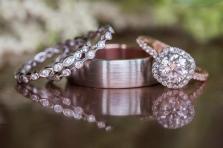| 212-751-3940 | Contact us |
| 5th Ave Showroom | Recently Viewed |
Showroom Hours: M-F by appointment
WE SHIP WORLDWIDE
 |
||
Women's Rings
Men's Rings
Engagement Rings

"We received the ring on Friday - it fits perfectly!!! It's just what John wanted ... and I love the inscription. Thanks so much for making this so easy for us!!!" -Jennifer B., Conn.

Lacy and Stephen are tickled pink over their rings!!
MORE REVIEWS
FOR QUESTIONS OR TO ORDER
CALL 212-751-3940
LIVE HELP ONLINE NOW
We Use Ethically Sourced Precious Metals & Conflict-Free Diamonds
PLEASE FOLLOW US ON:
 |
 |
 |
 |
 |
 Learn About Diamonds
Learn About Diamonds
The Basics: Cut, Clarity, Color & Carat Weight
Your jeweler can help you create the perfect ring that combines the timeless elegance of filigree with a high quality certified diamond. Diamonds are certified to meet specific quality standards for cut, color, clarity and carat weight by the GIA (Gemological Institute of America) and the AGSL (American Gem Society Laboratories). The GIA and AGSL provide fact sheets for many fine certified diamonds.Find More Information About Diamond Certification At:
The Gemological Institute of America
Also known as the GIA, is the world's foremost authority in gemology.
American Gem Society Laboratories
Also known as AGSL, this diamond grading laboratory was established to provide consumers with an unbiased, credible analysis of a diamond.
A Diamond's Cut
A diamond should be cut so that light reflects down into it and back up through the many facets. If a diamond is cut too shallow or too deep, light passes through the facets and down rather than being refracted back up to the admiring eye. Check with your jeweler for further guidance about cut and how this affects the sparkle of a diamond.
A Diamond's Clarity
Like water shining through a crystal clear glass of water, a diamond that is perfect is free of inclusions or imperfections. Inclusions are tiny fractures or trace minerals that have been present in the stone since its formation in the earth. Diamonds are rated for clarity using the following scale:
Clarity
Rating Description
FL Flawless, no internal or external finish flaws.
IF Internally flawless, no internal flaws.
VVS1 Very very slightly included.
VVS2 Very difficult to see inclusions under 10x magnification.
VS1 Very slightly included.
VS2 Difficult to see inclusions under 10x magnification, typically unable to see inclusions with unaided eye.
SI1 Slightly included.
SI2 Easy to see inclusions under 10x magnification, may not be able to see inclusions with unaided eye.
I Inclusions visible with unaided eye.
When a diamond is certified, the gemologist provides a summary of any inclusions (imperfections) in a diamond — details about the number, location, size and type.
A Diamond's Color
The brilliance of a diamond’s sparkle is affected by the presence or absence of color. Color is rated on the following scale:
A diamond is considered colorless or near-colorless if it is graded "D" through "J". These diamonds are considered an excellent value. They appear colorless to the naked eye, unless they are compared with diamonds of even higher color grade.
A Diamond's Carat Weight
If you invest in quality rather than quantity, you will never be disappointed. High standards of quality are a reflection of character. More important than the size of the diamond is the brilliance and the light that it casts.
Visit us by appointment at:
608 Fifth Avenue (corner 49 Street) Suite 509, New York, NY 10020 212-751-3940
608 Fifth Avenue (corner 49 Street) Suite 509, New York, NY 10020 212-751-3940
Thank you!
Visit us by appointment at:
608 Fifth Avenue Suite 509
(corner 49 Street)
New York, NY 10020
212-751-3940
Thank you!
608 Fifth Avenue Suite 509
(corner 49 Street)
New York, NY 10020
212-751-3940
Thank you!
Copyright 1999-2025 Wedding Ring Originals
Copyright 1999-2025 Wedding Ring Originals
Copyright 1999-2025 Wedding Ring Originals



